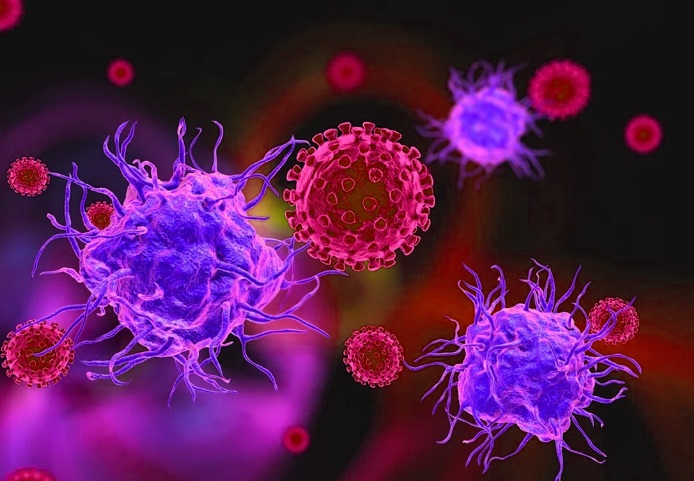Nikhil Prasad Fact checked by:Thailand Medical News Team Jan 20, 2025 3 months, 2 weeks, 6 days, 6 hours, 52 minutes ago
Medical News: Scientists from Université de Montréal, Université de Sherbrooke, and Institut de recherches cliniques de Montréal have unraveled a critical immune process in SARS-CoV-2 infection, providing a deeper understanding of how our innate immunity responds to the virus. This
Medical News report delves into their groundbreaking discovery, shedding light on how plasmacytoid dendritic cells (pDCs) interact with infected cells to produce vital interferons (IFNs). The study highlights the crucial role of physical contact between pDCs and infected cells, mediated by specific molecular interactions.
 Canadian Scientists Uncover How Plasmacytoid Dendritic Cells Detect SARS-CoV-2
pDCs: The First Responders of Immunity
Canadian Scientists Uncover How Plasmacytoid Dendritic Cells Detect SARS-CoV-2
pDCs: The First Responders of Immunity
Plasmacytoid dendritic cells, a unique subset of immune cells, are known for their ability to produce type I interferons, which are essential in fighting viral infections. Unlike other immune cells, pDCs are highly efficient in detecting viral infections and mounting an early response. The new study reveals that pDCs primarily sense SARS-CoV-2 through direct interaction with infected cells rather than through cell-free viral particles. This process involves adhesion molecules such as CD54 (ICAM-1) and CD11a (LFA-1), forming a bridge for communication and immune activation.
The Role of Physical Contact in Immune Activation
The researchers demonstrated that physical contact between pDCs and infected cells is essential for triggering the release of interferons. Using co-culture systems, they found that when pDCs were separated from infected cells by a membrane, interferon production dropped by up to 95%. This underscores the importance of direct cell-to-cell interactions in the immune sensing of SARS-CoV-2. Interestingly, the study showed that CD11a expression on infected cells could be induced during co-culture with immune cells, creating a feedback loop that amplifies the immune response.
Variants of Concern and Immune Evasion
One of the most intriguing findings is how SARS-CoV-2 variants of concern (VOCs) have evolved mechanisms to evade detection by pDCs. The researchers observed that pDCs sensed cells infected with the Alpha variant less efficiently compared to cells infected with the original Wuhan strain. This impaired sensing was linked to reduced CD11a expression on infected cells and a lower frequency of cell conjugates formed with pDCs. Such adaptations may allow the virus to dampen interferon responses, facilitating its spread within the host.
Key Findings of the Study
-Efficient Sensing Through Contact: The study confirmed that pDCs detect SARS-CoV-2-infected cells more effectively than cell-free viral particles, leading to a robust production of type I interferons.
-Molecular Interplay: The interaction between CD54 on infected cells and CD11a on pDCs is critical for the immune response. Blocking either molecule significantly reduced interfer
on production.
-Bidirectional Feedback: CD11a expression on infected cells is induced during co-culture with immune cells, potentially creating a bidirectional communication that enhances immune sensing.
-Variant-Specific Evasion: The Alpha variant showed impaired detection by pDCs, attributed to lower CD11a expression and reduced formation of immune synapses.
-Polarized Cell Models: Using polarized epithelial cells, the study demonstrated that interferon production is localized to the basolateral side, where immune cells have direct contact with infected cells.
Implications for COVID-19 Management
These findings provide critical insights into the early immune response to SARS-CoV-2 and highlight potential targets for therapeutic intervention. Enhancing the ability of pDCs to detect infected cells could improve antiviral defenses, particularly against variants that evade immune detection. Furthermore, understanding the molecular mechanisms of immune evasion by VOCs can inform the design of next-generation vaccines and treatments.
A Closer Look at the Mechanisms
The study employed a range of experimental models, including human epithelial cells and primary airway cells, to dissect the interactions between pDCs and SARS-CoV-2-infected cells. The researchers used blocking antibodies to inhibit the CD54-CD11a interaction, demonstrating its pivotal role in interferon production. They also explored the directional release of interferons in polarized cell systems, emphasizing the importance of basolateral sensing in respiratory infections.
Conclusion
This research underscores the critical role of plasmacytoid dendritic cells in the immune response to SARS-CoV-2. By elucidating the molecular interactions that drive interferon production, the study provides a foundation for developing strategies to enhance innate immunity against the virus. The findings also highlight the sophisticated ways in which SARS-CoV-2 variants adapt to evade immune detection, offering new avenues for combating viral evolution.
The study findings were published in the peer-reviewed Journal of Virology.
https://journals.asm.org/doi/10.1128/jvi.01235-24
For the latest COVID-19 News, keep on logging to Thailand
Medical News.
Read Also:
https://www.thailandmedical.news/news/immunology-news-japanese-scientists-discover-that-dendritic-cells-kill-cd47-deficient-t-cells-via-necroptosis
https://www.thailandmedical.news/news/covid-19-news-study-finds-alteration-of-corneal-nerve-parameters-and-increase-in-dendritic-cells-activation-2-years-after-covid-19-infection
https://www.thailandmedical.news/news/russian-scientist-uncover-how-sars-cov-2-fusion-peptides-disrupt-host-cell-membranes
https://www.thailandmedical.news/news/indian-study-unveils-protein-changes-in-lung-cells-in-response-to-sars-cov-2-orf3a
https://www.thailandmedical.news/news/new-insights-into-sars-cov-2-nsp12-activity
https://www.thailandmedical.news/articles/coronavirus
